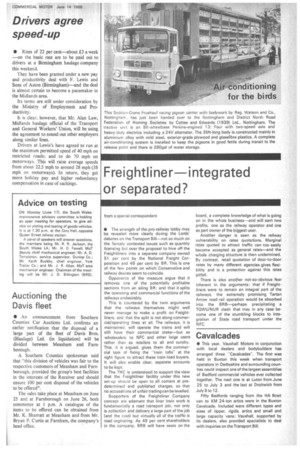Freightliner integrated or separated?
Page 29

If you've noticed an error in this article please click here to report it so we can fix it.
from a special correspondent • The strength of the pro-railway lobby may be revealed more clearly during the Lords' debates on the Transport Bill—not so much on the fiercely contested issues such as quantity licensing but over the proposal to hive off the Freightliners into a separate company owned 51 per cent by the National Freight Corporation and 49 per cent by BR. This is one of the few points on which Conservative and railway desires seem to coincide.
Opponents of the measure argue that it removes one of the potentially profitable sections from an ailing BR; and that it splits the operating and commercial functions of the railways undesirably.
This is countered by the twin arguments that the railways themselves might well never manage to make a profit on Freightliners, and that the split is not along commercial/operating lines at all. The railways, it is maintained, will operate the trains and will still have their commercial stake—but as wholesalers to NFC and other large users rather than as retailers to all and sundry. This, it is argued, gives them the commercial task of fixing the "train tolls" at the right figure to attract these train-load buyers. It will also enable clear, separate accounts to be kept.
The THC is understood to support the view that the Freightliner facility under this new set-up should be open to all comers at predetermined and published charges, so that no accusations of u nfair trading can be levelled.
Supporters of the Freightliner Company concept are adamant that liner train work is fundamentally a road transport job; not only is collection and delivery a large part of the job land the cost) but virtually all of the traffic is road-orginating. As 49 per cent shareholders in the company, BRB will have seats on the board, a complete knowledge of what is going on in the whole business and will earn two profits, one as the railway operator and one as part owner of the biggest user.
Another danger is seen as the railway vulnerability on rates quotations. Marginal rates quoted to attract traffic can too easily become accepted as general rates—and the whole charging structure is then undermined. By contrast, retail quotation of door-to-door rates by many different agencies gives flexibility and is a protection against this rates pitfall.
There is also another not-so-obvious fear inherent in the arguments: that if Freightliners were to remain an integral part of the railways, the extremely promising Tartan Arrow road-rail operation would be absorbed into the BRB—perhaps precipitating a TGWU/NUR clash that may in any case become one of the stumbling blocks to integration of State road transport under the NFC.




























































































































